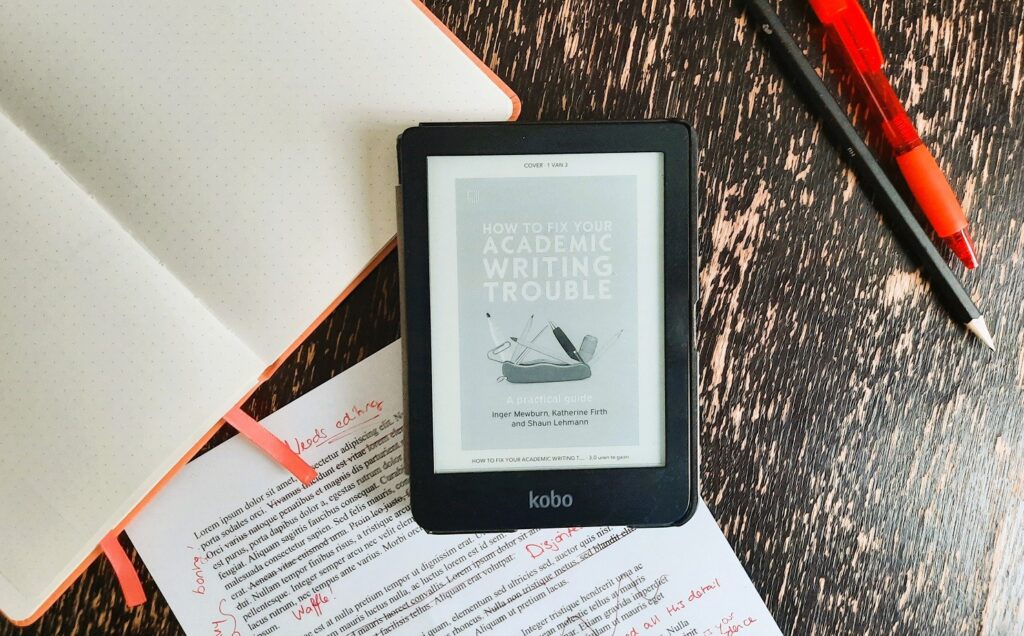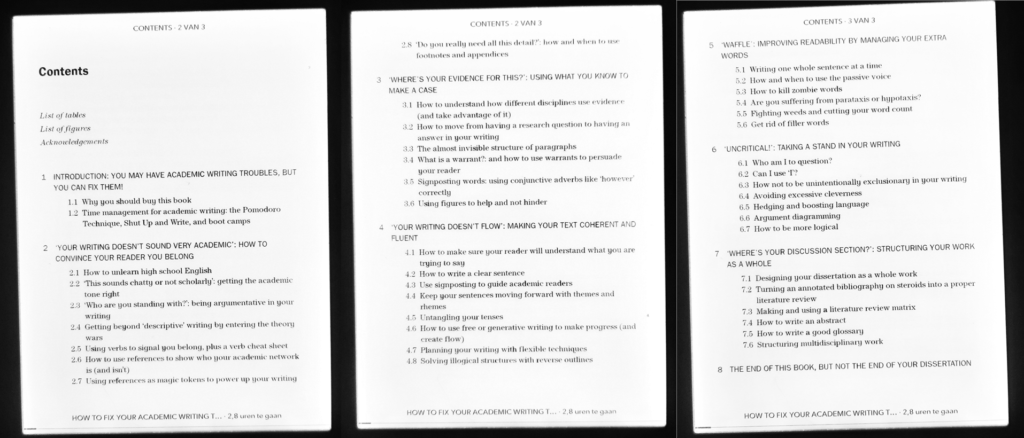I ‘grew up’ academically reading Inger Mewburn’s blog, devouring every post I could find when I was writing up my master’s thesis in 2015. I kept up with her posts ever since, so I was excited to finally read ‘How to Fix Your Academic Writing Trouble’, a great manual that does exactly what it says.
How to Fix Your Academic Writing Trouble is written by Inger Mewburn, Katherine Firth and Shaun Lehmann. They are based in Australia and are experts in their field, with a combined experience of over 30 years teaching research, writing and English skills to researchers.

What is academic writing trouble?
The authors describe academic writing trouble as getting confusing or vague feedback on your writing and not knowing how to fix it. For example, feedback such as ‘your writing doesn’t sound very academic’ or ‘where’s your evidence for this?’. They translate this feedback into concrete advice to address the problem and improve your dissertation.
How to use this book
The book is laid out into six content chapters aimed at specific types of feedback, such as not sounding academic enough, writing too unfocused, or having weak arguments. Because the chapters are named after a specific feedback, you can use them to look up which chapter is most relevant for you.
Each chapter contains about seven subchapters with solutions and more specific feedback. For example, the subchapters in chapter 4 (‘Your writing doesn’t flow’) address feedbacks such as ‘I’m not sure what you are trying to say here’ (subchapter 4.1), ‘Your sentences don’t make sense’ (4.2), ‘needs editing’ (4.3), and ‘where are you going with this’ (4.4).

How effective is ‘How to Fix Your Academic Writing Trouble’?
The book lives up to its promise. All feedback is carefully explained, sometimes even with entire history lessons. There are loads of examples to illustrate the problems, including example sentences and how to improve them.
I really like that the authors take their time to not only explain the problems, but also the solutions. Each strategy is thoroughly explained, and some chapters have dedicated exercises to apply the strategy to your own field of research.
What I like about this book
It’s very clear that the authors know what they’re talking about. They make explicit what we usually only learn implicitly by copying others. The book is chockful with great advice and the authors are honest about how to use it; they don’t push anything as a simple fix, but carefully explain how and when to apply the advice.
The book contains a wealth of explanation on why things are the way they are in academic writing. This makes for great context. I loved the history lesson on medieval invasions of England when the authors explain how to sound academic. I also appreciated the various comparisons between academic writing in HASS fields (Humanities and Social Sciences) and in STEM fields (Science, Technology, Engineering and Math), such as the difference between author-first and object-first citation styles.
The book is written in a friendly tone of voice. It feels like you have three mentors sitting beside you who are happy to help you with your writing. This makes it easy to read, unlike some other books in the academic writing self-help genre.
What I like less
The book is aimed at all academic writers working on their dissertation. However, a few sections seem less useful for STEM writing, particularly if you’re writing scientific publications as part of your dissertation. For example, I found the Tiny Text approach (Locate, Focus, Anchor, Report, Argue, Show Significance) for abstract writing more confusing than helpful. I prefer the good old Background, Methods, Results, Conclusions, and Implications.
If you struggle with metaphors, this book is not for you. The book relies heavily on metaphors to explain the various aspect of academic writing. While they are often useful – and it’s hard to explain such an abstract topic as writing without metaphors – I grew a bit tired after of them after multiple chapters of ‘fighting weeds’ and ‘laying bricks’.
And finally, a very mild critique (it’s more something I’m curious about). The authors frame academic writing somewhat negatively, calling it a ‘passive-aggressively competitive middle-class dinner party’. This left me feeling a bit gloomy. I don’t have that experience, and I wonder if this has something to with cultural differences between research fields.
When to use this book
All in all, I found this a great and interesting book with much more in-depth information than I’ve encountered before. I would recommend using this book if:
- The academic writing trouble covered in this book sounds familiar to you,
- You want to learn more about how academic writing works,
- You want to pick up some new writing tools,
- Or you want to get better at explaining academic writing to others, for example your own students.
Enjoyed this post? Sign up for my monthly newsletter and get new updates delivered straight to your inbox:
[mailerlite_form form_id=2]